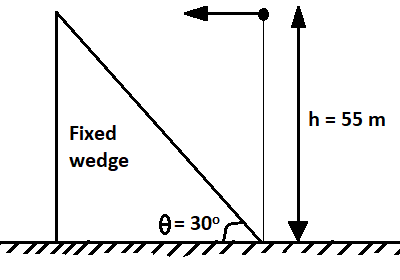Answer
64.8k+ views
Hint: In order to solve this question you have to break the velocity components of the moving particle and write the force equation and then apply the equilibrium condition. You should remember all the concepts related to wedges. Also, keep in mind that in this question the particle’s velocity component parallel to the inclined plane should be zero.
Complete step by step solution:
Considering plane along the wedge axis,
As we know that when a particle collides with the plane, its velocity component which is parallel to the inclined plane should be zero.
$ \Rightarrow u\cos \theta - g\sin \theta \times t = 0$
On further solving, we have
$ \Rightarrow t = \dfrac{u}{{g\tan \theta }}$
And also from the same equation, we get the value of u as
$ \Rightarrow u = gt \times \tan \theta $
On putting $\theta = 30^\circ $ in the above equation, we have
$ \Rightarrow u = \dfrac{{gt}}{{\sqrt 3 }}$ …….(1)
Now, consider the plane along with the x-y axis, we have
Horizontal displacement before the particle hits the plane $ = ut$
And, the vertical displacement during the t time $ = \dfrac{1}{2}g{t^2}$
Now, $\tan 30^\circ = \dfrac{{h - \dfrac{1}{2}g{t^2}}}{{ut}}$
$ \Rightarrow \dfrac{1}{{\sqrt 3 }} = \dfrac{{h - \dfrac{1}{2}g{t^2}}}{{ut}}$
On solving the above equation for t, we have
$ \Rightarrow t = \sqrt {\dfrac{{6h}}{{5g}}} $
On putting the given values $h = 55m$ and $g = 9.8m/{s^2}$ we get
$ \Rightarrow t = 2.5938\sec $
Now, putting that above value of time in the equation (1), we have
$ \Rightarrow u = \dfrac{{9.8 \times 2.5938}}{{\sqrt 3 }}$
On further solving this, we get the value of the initial velocity $u$ ,
$ \Rightarrow u = 14.69 \simeq 10\sqrt 2 m/s$
Therefore, the correct option is (C).
Note: Always keep in mind that if the wedge is at rest then the problem should be solved by the normal way in which we write the force equations and applying the equilibrium conditions and if the wedge is in accelerating motion then everything will be converted into a wedge frame of reference and then solve the question by applying pseudo force.
Complete step by step solution:
Considering plane along the wedge axis,
As we know that when a particle collides with the plane, its velocity component which is parallel to the inclined plane should be zero.
$ \Rightarrow u\cos \theta - g\sin \theta \times t = 0$
On further solving, we have
$ \Rightarrow t = \dfrac{u}{{g\tan \theta }}$
And also from the same equation, we get the value of u as
$ \Rightarrow u = gt \times \tan \theta $
On putting $\theta = 30^\circ $ in the above equation, we have
$ \Rightarrow u = \dfrac{{gt}}{{\sqrt 3 }}$ …….(1)
Now, consider the plane along with the x-y axis, we have
Horizontal displacement before the particle hits the plane $ = ut$
And, the vertical displacement during the t time $ = \dfrac{1}{2}g{t^2}$
Now, $\tan 30^\circ = \dfrac{{h - \dfrac{1}{2}g{t^2}}}{{ut}}$
$ \Rightarrow \dfrac{1}{{\sqrt 3 }} = \dfrac{{h - \dfrac{1}{2}g{t^2}}}{{ut}}$
On solving the above equation for t, we have
$ \Rightarrow t = \sqrt {\dfrac{{6h}}{{5g}}} $
On putting the given values $h = 55m$ and $g = 9.8m/{s^2}$ we get
$ \Rightarrow t = 2.5938\sec $
Now, putting that above value of time in the equation (1), we have
$ \Rightarrow u = \dfrac{{9.8 \times 2.5938}}{{\sqrt 3 }}$
On further solving this, we get the value of the initial velocity $u$ ,
$ \Rightarrow u = 14.69 \simeq 10\sqrt 2 m/s$
Therefore, the correct option is (C).
Note: Always keep in mind that if the wedge is at rest then the problem should be solved by the normal way in which we write the force equations and applying the equilibrium conditions and if the wedge is in accelerating motion then everything will be converted into a wedge frame of reference and then solve the question by applying pseudo force.
Recently Updated Pages
Write a composition in approximately 450 500 words class 10 english JEE_Main

Arrange the sentences P Q R between S1 and S5 such class 10 english JEE_Main

What is the common property of the oxides CONO and class 10 chemistry JEE_Main

What happens when dilute hydrochloric acid is added class 10 chemistry JEE_Main

If four points A63B 35C4 2 and Dx3x are given in such class 10 maths JEE_Main

The area of square inscribed in a circle of diameter class 10 maths JEE_Main

Other Pages
Excluding stoppages the speed of a bus is 54 kmph and class 11 maths JEE_Main

In the ground state an element has 13 electrons in class 11 chemistry JEE_Main

Electric field due to uniformly charged sphere class 12 physics JEE_Main

A boat takes 2 hours to go 8 km and come back to a class 11 physics JEE_Main

According to classical free electron theory A There class 11 physics JEE_Main

Differentiate between homogeneous and heterogeneous class 12 chemistry JEE_Main




